Egmond Castle
Egmond Castle (Dutch: Kasteel Egmond), also called the Ruins of Egmond (Dutch: Ruïne van Egmond), is a ruined medieval castle in the Dutch province of North Holland. It is located in Egmond aan den Hoef in the municipality of Bergen and lies about 7 kilometres (4.3 mi) west of Alkmaar. The castle dates from the 11th century and is the ancestral seat of the Egmond family, whose members became sovereign Dukes of Guelders, Counts of Egmond and Princes of Gavere, Counts of Buren and Leerdam.[1] It is a national monument of the Netherlands.
_Het_Kasteel_Egmond-aan-den-Hoef_(ca.1570)_Stadhuis_van_Zottegem_1-09-2018.jpg)
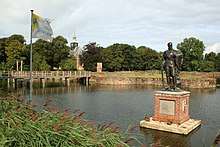
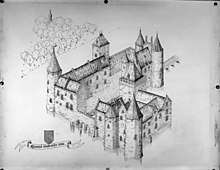
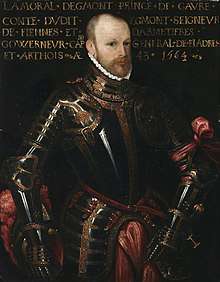
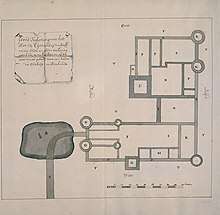
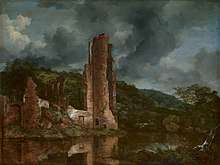
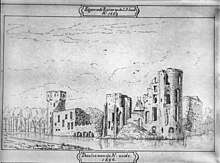
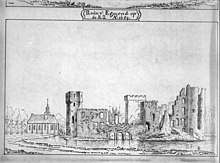

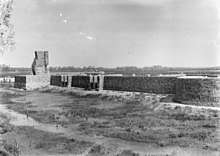
History
Origins
The origins of Egmond Castle is closely connected to Egmond Abbey, which was founded by the counts of Holland in Egmond-Binnen. When they Abbey lands became so large, the abbot decides to appoint a certain Berwout as steward of these estates in 1129. Berwout and his descendants live in a (fortified) farm or manor ("Hoeve") north of the abbey. As Berwout and his descendants took part in the crusades, they were rewarded with the hereditary lordship over Egmond.
First Castle | 1206–1285
Walter I, Lord of Egmond got involved in the Loon war, a war of succession over the County of Holland (and its dependency Zeeland) from 1203 until 1206, brought on by the death of count Dirk VII. During this war, Louis II, Count of Loon sets the fortified manor at fire in 1203. Walter I decided to build a circular stone castle as replacement. It had a diameter of 27 meters, a strong keep on the south side and a curtain wall. The main purpose was to serve as a place for refuge and defence in times of peril. The main living and residential buildings were in the forecourt. This circular castle existed until the end of the 15th century.
Second Castle - First Building Phase | 1285–325
William II, Lord of Egmond constructed a new castle in the forecourt as a replacement for the old circular castle. He divided the forecourt in a western and eastern side. On the eastern side, the main castle was erected with a large tower, the so called donjon. And on the western side the forecourt was erected including two towers. In the same time, the castle chapel (Dutch: slotkapel) was also built.
Third Castle - Second Building Phase | 1325–1573
The second castle was destroyed by the Frisians in 1321. John I, Lord of Egmond erected a new castle as a replacement.
John III of Egmont was the first Count of Egmont as well as an important statesman in the Burgundian Netherlands. He decided to enlarge and decorate the castle: a large hall including paintings of his ancestors, towers and a beautiful gatehouse with turrets on each corner were added, wooden bridges were replaced by stone ones. The main tower, the donjon, gets a height of 28 metres. People call the castle the largest and most beautiful one of Holland.
As the Egmond family rose to prominence within the Burgundian Netherlands, they spent more and more time in the south of the Netherlands, e.g. in the Egmont Palace in Brussels, the Egmont castle in Zottegem or the castle in La Hamaide.
Lamoraal I, Count of Egmont and first prince of Gavere was the grandson of John III. He was a leading general and statesman in the Spanish Netherlands during the 16th century. His beheading in Brussels in 1568 sparked the national uprising which led to the independence of the Netherlands.[2] Troops led by Diederik Sonoy set both Egmond castle and the abbey on fire in 1573. The destruction was at the command of the Prince of Orange to prevent that the Spanish army could occupy these strategic locations.
Ruins
Count Lamoraal II, son of Lamoraal I, was the last member of the Egmond family who owned the castle. Due to debts, he was forced to sell the castle and the surrounding estates to the States of Holland and West Friesland in 1607, who remained the owner for the remainder of the 17th century. Gerrit van Egmond van Nijenburg, a scion from a younger (bastard) branch of the Egmond family, decided to buy the ruins in 1722. His son, Jan van Egmond van Nijenburg, restored two towers at the entrance of the castle.
Just like the Ruins of Brederode the ruins of Egmond Castle became a favourite subject of the artists in the Dutch golden age. Painters like Meindert Hobbema and Jacob van Ruisdael or sketchers like Roelant Roghman or Cornelis Pronk depicted the ruins in romantic settings or how they imagined the castle looked like in more glorious times.[3] These paintings are scattered around the world and can be admired in places like the Rijksmuseum in Amsterdam or the Art Institute of Chicago.[4]
Ms Jacoba van Foreest, married with Mr Tinne, became proprietors of the ruins in 1798. They are responsible for the disappearance of the ruins, as they sold it for demolition with exception of the so-called 'rentmeestertoren' or 'clock tower'. However, in the end, they stopped the maintenance and tore it down in 1832. Nothing remained of the castle as from 1836 onwards. The loss of the castle ruins started discussions in the Netherlands around heritage awareness and how to treat monuments. As a result, Brederode castle, the other great ruins in Holland, became one of the first national monument of the Netherlands.
Excavations
The province of North Holland became the owner of the castle grounds in 1933, nothing more than a swamp. They immediately started to perform archaeological excavations, which lasted until 1936. Both the fundaments of the first circular and the second square castle were discovered, and not only the exterior walls, but also some of the interior walls. Further, they established that the castle did not have cellars. The decision was made to brick up the walls to raise the fundaments above the grounds. These are the ruins we see today, with some small remainder of the clock tower.
Modern times
Today, the ruins can freely be visited. A statue has been erected in memory of count Lamoraal I of Egmont in 1997, a copy from the statue which stands in the 'Egmont city' Zottegem in Flanders. From time to time, there a discussions to restore (parts of the) castle, but none has been realized.
Bibliography
- A. Beekman: "Het slot op den Hoef", 1961
- Arnold C.M. Burger: Het kasteel van Egmond, Uitgeverij Pirola Schoorl, Schoorl 1988/ 2008
- E.H.P. Cordfunke: "Macht en aanzien", Walburg Pers, Zutphen 2013
- J.W. Groesbeek: "Middeleeuwse kastelen in Noord-Holland", Nederlandse Kastelen Stichting, Rijswijk 1981
- Hans Louis Janssen, Annemieke Kylstra and Ben Olde Meierin: "1000 jaar kastelen in Nederland", Stichting Matrijs, Utrecht 1996
- J. Van Lennep and Hofdijk: "Merkwaardige kastelen in Nederland, deel I", Leiden 1883
- Jaap Renaud: "Hoe heeft het slot te Egmond er uit gezien", in : Elsevier's Geïllustreerd Maandschrift nr 49(1939) nr.98, 1939
- Paul E. van Reyen: "Middeleeuwse kastelen in Nederland", Haarlem 1979
- D. Vis: "De fundamenten van het kasteel te Egmond aan den Hoef", 1938
References
- Dek, Dr. W.A.E., Genealogie der Heren en Graven van Egmond. The Hague, 1958; pp. 21-33 and pp. 48-64. Coppens, Thera, "Buren, Egmond en Oranje; Over heren, graven en prinsen" Buren, 1989; pp.14-46
- "Egmont (Egmond), Lamoral, Count of". Encyclopædia Britannica Eleventh Edition. 1911.
- "Die Ruinen von Schloss Egmond in Egmond aan de Hoef by MeindertHobbema". www.artnet.com.
- "Landscape with the Ruins of the Castle of Egmond - The Art Institute of Chicago". www.artic.edu.
External links
| Wikimedia Commons has media related to Category:Kasteel Egmond. |
- http://www.netherlands-tourism.com/egmond-castle-ruins/
- http://www.castles.nl/egmond-castle
- https://huisvanhilde.nl/verhalen/de-ruine-van-het-kasteel-van-egmond/
- https://www.kasteleninnederland.nl/kasteeldetails.php?id=62
- https://www.huysegmont.nl/
- https://www.historischegmond.nl/egmond-aan-den-hoef
- http://www.slotkapel.nl/ Website of the castle chapel